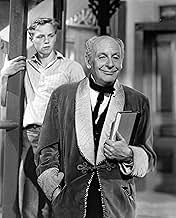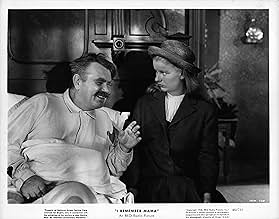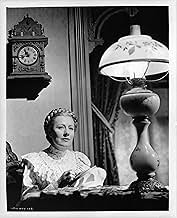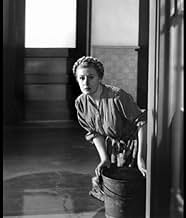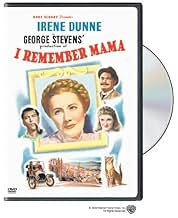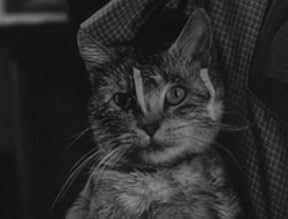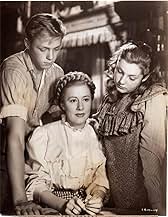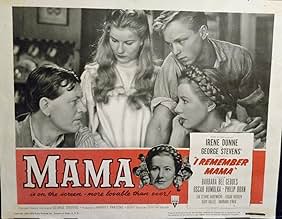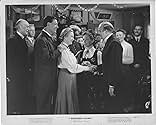IMDb रेटिंग
7.8/10
6.4 हज़ार
आपकी रेटिंग
1910 में एक नार्वेजियन अप्रवासी परिवार के उतार-चढ़ाव के किस्से.1910 में एक नार्वेजियन अप्रवासी परिवार के उतार-चढ़ाव के किस्से.1910 में एक नार्वेजियन अप्रवासी परिवार के उतार-चढ़ाव के किस्से.
- निर्देशक
- लेखक
- स्टार
- 5 ऑस्कर के लिए नामांकित
- 4 जीत और कुल 9 नामांकन
Cedric Hardwicke
- Mr. Jonahan Hyde
- (as Sir Cedric Hardwicke)
Peggy McIntire
- Christine Hanson
- (as Peggy McIntyre)
Stanley Andrews
- Minister
- (बिना क्रेडिट के)
George Atkinson
- Postman
- (बिना क्रेडिट के)
फ़ीचर्ड समीक्षाएं
I finally sat down and watched this movie completely this morning and was completely astounded by the greatness of it.
I knew it was a good movie, but it was one of those movies I always thought was too good to be true, too sweet, too goody-goody.
Boy, was I wrong. It was a little bit of history, it was every family rolled into one movie.
I could identify with almost every scene in the movie and not because of the era but because of the feelings it provoked. There was so much warmth, so much hope and yet it wasn't the "perfect" family, it was just people living life on life's terms.
I'm so glad I finally took the time to watch "I Remember Mama"
I knew it was a good movie, but it was one of those movies I always thought was too good to be true, too sweet, too goody-goody.
Boy, was I wrong. It was a little bit of history, it was every family rolled into one movie.
I could identify with almost every scene in the movie and not because of the era but because of the feelings it provoked. There was so much warmth, so much hope and yet it wasn't the "perfect" family, it was just people living life on life's terms.
I'm so glad I finally took the time to watch "I Remember Mama"
Funny, warm movie about Norwegian family in San Francisco before WW I. How Irene Dunne lost the Oscar to Jane Wyman (Johnny Belinda) is a mystery. Dunne is so totally wonderful in this film--and what a film. Beautifully directed by George Stevens, he captures all the humor and life of this family. Stevens also uses techniques like fore- and background action--there's always several things going on in every scene. He also uses overlapping dialog 20 years before Robert Altman made it fashionable. And what a perfect cast. Irene Dunne (maybe her best performance ever) stars with Barbara Bel Geddes, Oscar Homolka, and Ellen Corby (heartbreaking yet funny as Trina)--all Oscar nominated. Then there is Philip Dorn, Edgar Bergen, Rudy Vallee, Hope Landin, Edith Evanson, Barbara O'Neil, Florence Bates, Cedric Hardwicke, and Steve Brown. The novel by Kathryn Forbes spawned this movie, a play, a TV series, and finally a Broadway musical. At one point Greta Garbo was considered as Mama, and even Marlene Dietrich sought the role. Thank goodness they gave it to Irene Dunne! The aunts as played by Corby, Landin, and Evanson are wonderful. And oh BTW, Homolka lost to Walter Huston for The Treasure of the Sierra Madre, while Corby and Bel Geddes lost to Claire Trevor for Key Largo.
I Remember Mama was released 68 years ago and although Mrs. Shullivan and my own mother have been deceased for quite some time, we could not help but draw comparisons between our own mothers and the role of Irene Dunne who plays the family matriarch Mama Hansen. The story follows Mama and Papa Hansens' immigration from Norway to San Francisco and where they struggle week by week, pay day to pay day, to raise their four children who range in age from 8 to 18.
Every Saturday morning Mama's ritual would be to corral her family around the kitchen table and distribute Papa's weekly pay amongst the most critical bills that they had to pay such as their rent to their landlord, groceries, the children's clothing needs and education for books and writing material. Every week Mama would comment "Good we have enough money this week so there is no need to have to touch our bank account". Mama and Papa also retained what they called their "little bank" which held a few coins in a metal tin which periodically they would need to resort to in an effort to make ends meet each week.
Anyone who lived through the baby boomer years of the 1940's – through the 1960's would understand that "getting by through compromise and doing without" was a way of life whereas children of today call it "get it, buy it, and pay for it later". Mrs. Shullivan and I thoroughly enjoyed this films story which was narrated by the Hansen's eldest daughter Katrin, played by Barbara Bel Geddes. Of course this was a simpler time in the early 1900's and one of the great Directors of all time George Stevens, stuck to the script and allowed his audience to enjoy a simpler time in American history and the daily living rituals of an immigrant Norwegian family that extended to three Aunts (Jenny, Sigrid and spinster Trina played by Ellen Corby) and one gruff Uncle Kris (played superbly by Oskar Homolka) who was both feared and respected.
The four children loved their parents immensely and although they suffered financially through hard times their strength was in the extended family unit comprised of the Hansen's three Aunts, one young cousin, and one gruff Uncle Kris who owned his own car and who had a female companion who was a mystery woman which was reflected by the family always wondering if she was Uncle Kris's housemaid or his wife? Of course the Hansen's needed to take on a boarder (my own family had two boarders in the 1950's) who always committed to paying his board the following week. In lieu of payment the boarder Mr. Hyde (played by Cedric Hardwicke) would read classic novels out loud to the family each night with so much passion and emotion that it inspired the eldest daughter Katrin (played by Barbara Bel Geddes) to want to become an author herself.
Throughout the film we see the families reliance on Mama Hansen to provide strength, a positive attitude and most especially hope to the Hansen clan. Near the end we come to realize that Mama was telling a white lie to her children, and if you have not shed a tear or two by this point in the film then I can only assume you were born after year 2000 when hardship is an unknown term to many. Mrs. Shullivan and I truly loved this film and directors such as George Stevens who directed I remember Mama rank right up there with the very best directors such as Frank Capra, John Ford, and George Cukor.
If you want to see a film that allows you to reminisce about your own childhood and relationship with your extended family then this film will be sure to bring back some of your old memories to the forefront with the narration by then 26 year old actress Barbara Bel Geddes who explains her upbringing and the loving relationship she shared with her siblings, her father, and most importantly her Mama played with such love and thoughtfulness as only actress Irene Dunne could have accomplished. Be prepared to shed a few tears. I rated it a strong 8 out of 10 for director George Steven's unique ability to take the simplest of story lines, that being an early 1900's immigrant families daily struggles that are conquered through the family bond.
Every Saturday morning Mama's ritual would be to corral her family around the kitchen table and distribute Papa's weekly pay amongst the most critical bills that they had to pay such as their rent to their landlord, groceries, the children's clothing needs and education for books and writing material. Every week Mama would comment "Good we have enough money this week so there is no need to have to touch our bank account". Mama and Papa also retained what they called their "little bank" which held a few coins in a metal tin which periodically they would need to resort to in an effort to make ends meet each week.
Anyone who lived through the baby boomer years of the 1940's – through the 1960's would understand that "getting by through compromise and doing without" was a way of life whereas children of today call it "get it, buy it, and pay for it later". Mrs. Shullivan and I thoroughly enjoyed this films story which was narrated by the Hansen's eldest daughter Katrin, played by Barbara Bel Geddes. Of course this was a simpler time in the early 1900's and one of the great Directors of all time George Stevens, stuck to the script and allowed his audience to enjoy a simpler time in American history and the daily living rituals of an immigrant Norwegian family that extended to three Aunts (Jenny, Sigrid and spinster Trina played by Ellen Corby) and one gruff Uncle Kris (played superbly by Oskar Homolka) who was both feared and respected.
The four children loved their parents immensely and although they suffered financially through hard times their strength was in the extended family unit comprised of the Hansen's three Aunts, one young cousin, and one gruff Uncle Kris who owned his own car and who had a female companion who was a mystery woman which was reflected by the family always wondering if she was Uncle Kris's housemaid or his wife? Of course the Hansen's needed to take on a boarder (my own family had two boarders in the 1950's) who always committed to paying his board the following week. In lieu of payment the boarder Mr. Hyde (played by Cedric Hardwicke) would read classic novels out loud to the family each night with so much passion and emotion that it inspired the eldest daughter Katrin (played by Barbara Bel Geddes) to want to become an author herself.
Throughout the film we see the families reliance on Mama Hansen to provide strength, a positive attitude and most especially hope to the Hansen clan. Near the end we come to realize that Mama was telling a white lie to her children, and if you have not shed a tear or two by this point in the film then I can only assume you were born after year 2000 when hardship is an unknown term to many. Mrs. Shullivan and I truly loved this film and directors such as George Stevens who directed I remember Mama rank right up there with the very best directors such as Frank Capra, John Ford, and George Cukor.
If you want to see a film that allows you to reminisce about your own childhood and relationship with your extended family then this film will be sure to bring back some of your old memories to the forefront with the narration by then 26 year old actress Barbara Bel Geddes who explains her upbringing and the loving relationship she shared with her siblings, her father, and most importantly her Mama played with such love and thoughtfulness as only actress Irene Dunne could have accomplished. Be prepared to shed a few tears. I rated it a strong 8 out of 10 for director George Steven's unique ability to take the simplest of story lines, that being an early 1900's immigrant families daily struggles that are conquered through the family bond.
This film is absolutely one of the most heart-warming and wholesome classics of all time. Irene Dunne ("Mama") is STUNNING as is her comically gruff character opposite ("Uncle Chris")portrayed brilliantly by Oscar Homolka. Both of their performances here were nominated for Academy awards in 1945.To boot, this film had one of the most amazing directors ever George Stevens(the director of PENNY SERENADE-also in desperate need of a higher quality DVD release-, Talk of The Town, Shane & Giant just to name a few) The story of I REMEMBER MAMA is rich, dramatic, and yet manages to be highly comical at moments-has the same feel-good qualities that other 40's films like "It's A Wonderful Life" brought to the screen in only a manner that the 1940's has been capable of creating since then. I can not understand why this has not yet been released on DVD along with two other equally amazing/classic pictures from the mid-1940s, Kazan's "A TREE GROWS IN BROOKLYN" (1945) & The PITCURE OF DORIAN GRAY from the same year. PLEASE RELEASE, I REMEMBER MAMA, A TREE GROWS IN BROOKLYN, THE PITCURE OF DORIAN GRAY and a higher quality DVD restoration of PENNY SERENADE!!! Thank you.
It was a funny old post-war industry. I Remember Mama came out of RKO when that studio was in its darkest phase, and most of its output was creepy little horrors and thrillers, under the guidance of Dore Schary, who a few years after this would add a streak of gritty realism to MGM's dream world. And although this was one of RKO's comparatively small number of A-pictures released around this time, much of its crew were veterans of the B-unit – writer DeWitt Bodeen, cinematographer Nicholas Musuraca and composer Roy Webb had all worked on Cat People amongst other Val Lewton horrors. And director George Stevens, even though his pre-war output was mostly romantic comedies, was emotionally troubled by his wartime experiences and his work subsequently took an a far more sombre tone. But in spite of all this, I Remember Mama is one of the most sweetly uplifting pictures of its era.
This is perhaps not so surprising when we look a bit more closely at the people involved here. It's true, Bodeen's scripts for the Val Lewton horrors were deeply disturbing and filled with uncomfortable psychological insights, but they were also very humane and sympathetic towards villains and victims alike – something you don't often get in the genre. They were also very carefully balanced, with a real understanding of structure. You can see that understanding in I Remember Mama, particularly in the way it uses comedy. Funny moments dovetail into sad ones and vice versa, which gives more weight to the poignant scenes and stops them becoming mawkish.
The cinematography of Musuraca once gave those RKO B-horrors their distinctive look – much of the screen shrouded in mysterious darkness, with key elements picked out in stark white. With I Remember Mama (for which he received his only Oscar nomination) he actually does something quite similar, albeit for very different effect. In interior shots he makes the backgrounds rather indistinct, while the actors are sharp and clear. This encourages us not to focus on the humbleness of the location, but on the people within it. However there are points of brightness on the home set where most of the story takes place, from windows or plates, which gives depth and character to the place when it is needed. In fact, this whole set is a lovely design – each room is very small, but there seem to be numerous doors and stairways coming off room, giving a feeling of cosiness without confinement.
At first glance, I Remember Mama is an anomaly in the post-war career of director George Stevens. With a few exceptions, all his pictures before he did war service in Europe were comedies, and all his pictures after the war are not except this one. However, while there is a lot of humour in I Remember Mama, and Stevens no doubt realised the importance of it, it all comes from Bodeen's screenplay (and John van Druten's stage play). It is not the style of rigorously timed physical comedy that Stevens used to personally build into his pictures, such as the breakfast routine in Woman of the Year.
But there are other ways in which Stevens has changed. He has become a little more subtle and relaxed. His earlier pictures contain a lot of camera movement and very intense close-ups. Now he often calmly keeps the camera back, showing the characters moving around their environment. He is very much concerned with movement within the frame, such as a swinging pendulum that gives a soothing quality to the image. Perhaps the best example is in the hospital when Irene Dunne visits Dagmar in the night. Rather than closing in and making the moment just about mother and daughter, Stevens expresses it through the entire room, with a billowing curtain in one corner keeping a tiny bit of movement going, and here and there children sitting up to listen, really capturing the tenderness and intimacy.
Of course much of the charm of this picture comes not from how it is written or shot, but from who is in it. At the centre of things is a typically understanding and believable performance from Irene Dunne, perhaps the greatest actress never to win an Academy Award. She is supported by steady turns from Philip Dorn and Barbara Bel Geddes. However, the most truly excellent contributions are those of Edgar Bergen, Ellen Corby and, of course, Oskar Homolka. It is the impeccable timing and rapport between these three that make that all-important comedy element work.
I have mostly looked at this picture from the point of its being at odds to the careers of its creators, and some might say this is missing the point. After all, it simply goes to show that truly creative people are versatile. Still, it fascinates me that all that darkness and pessimism of RKO in the 1940s could still give us something as stirring and beautiful as I Remember Mama.
This is perhaps not so surprising when we look a bit more closely at the people involved here. It's true, Bodeen's scripts for the Val Lewton horrors were deeply disturbing and filled with uncomfortable psychological insights, but they were also very humane and sympathetic towards villains and victims alike – something you don't often get in the genre. They were also very carefully balanced, with a real understanding of structure. You can see that understanding in I Remember Mama, particularly in the way it uses comedy. Funny moments dovetail into sad ones and vice versa, which gives more weight to the poignant scenes and stops them becoming mawkish.
The cinematography of Musuraca once gave those RKO B-horrors their distinctive look – much of the screen shrouded in mysterious darkness, with key elements picked out in stark white. With I Remember Mama (for which he received his only Oscar nomination) he actually does something quite similar, albeit for very different effect. In interior shots he makes the backgrounds rather indistinct, while the actors are sharp and clear. This encourages us not to focus on the humbleness of the location, but on the people within it. However there are points of brightness on the home set where most of the story takes place, from windows or plates, which gives depth and character to the place when it is needed. In fact, this whole set is a lovely design – each room is very small, but there seem to be numerous doors and stairways coming off room, giving a feeling of cosiness without confinement.
At first glance, I Remember Mama is an anomaly in the post-war career of director George Stevens. With a few exceptions, all his pictures before he did war service in Europe were comedies, and all his pictures after the war are not except this one. However, while there is a lot of humour in I Remember Mama, and Stevens no doubt realised the importance of it, it all comes from Bodeen's screenplay (and John van Druten's stage play). It is not the style of rigorously timed physical comedy that Stevens used to personally build into his pictures, such as the breakfast routine in Woman of the Year.
But there are other ways in which Stevens has changed. He has become a little more subtle and relaxed. His earlier pictures contain a lot of camera movement and very intense close-ups. Now he often calmly keeps the camera back, showing the characters moving around their environment. He is very much concerned with movement within the frame, such as a swinging pendulum that gives a soothing quality to the image. Perhaps the best example is in the hospital when Irene Dunne visits Dagmar in the night. Rather than closing in and making the moment just about mother and daughter, Stevens expresses it through the entire room, with a billowing curtain in one corner keeping a tiny bit of movement going, and here and there children sitting up to listen, really capturing the tenderness and intimacy.
Of course much of the charm of this picture comes not from how it is written or shot, but from who is in it. At the centre of things is a typically understanding and believable performance from Irene Dunne, perhaps the greatest actress never to win an Academy Award. She is supported by steady turns from Philip Dorn and Barbara Bel Geddes. However, the most truly excellent contributions are those of Edgar Bergen, Ellen Corby and, of course, Oskar Homolka. It is the impeccable timing and rapport between these three that make that all-important comedy element work.
I have mostly looked at this picture from the point of its being at odds to the careers of its creators, and some might say this is missing the point. After all, it simply goes to show that truly creative people are versatile. Still, it fascinates me that all that darkness and pessimism of RKO in the 1940s could still give us something as stirring and beautiful as I Remember Mama.
क्या आपको पता है
- ट्रिवियाIrene Dunne worked with dialect coach Judith Sater for two months to perfect her Norwegian accent. Dunne became so immersed in getting her character's voice down that she used the accent around her home with her family.
- गूफ़In the shots of the uncle's trip to San Francisco, as the ferry is pulling into the dock, the Oakland Bay Bridge is seen in the background. This bridge was not built until 1933, yet this movie is set circa 1910.
- भाव
Katrin Hanson: [reading the novel that she's just finished] "For long as I could remember, the house on the Larkin Street Hill had been home. Papa and Mama had both born in Norway but they came to San Francisco because Mama's sisters were here, all of us were born here. Nels, the oldest and the only boy, my sister Christine and the littlest sister Dagmar but first and foremost I remember Mama".
- कनेक्शनEdited into The Waltons: The Awakening (1974)
टॉप पसंद
रेटिंग देने के लिए साइन-इन करें और वैयक्तिकृत सुझावों के लिए वॉचलिस्ट करें
- How long is I Remember Mama?Alexa द्वारा संचालित
विवरण
बॉक्स ऑफ़िस
- बजट
- $30,68,000(अनुमानित)
- चलने की अवधि2 घंटे 14 मिनट
- रंग
- पक्ष अनुपात
- 1.37 : 1
इस पेज में योगदान दें
किसी बदलाव का सुझाव दें या अनुपलब्ध कॉन्टेंट जोड़ें



